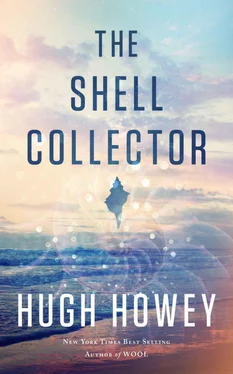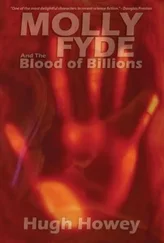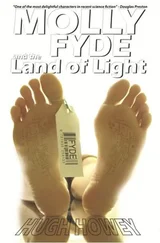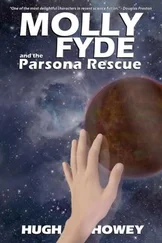From what I can tell, Ness is good at a lot of things—but reassuring people is not one of them.
“Probably a good idea to kill the book light,” he tells me. He turns on an interior light, which bathes the interior of the sub in a red glow.
“Is that a bad thing?” I ask. Red is always bad. This is a bad thing. Something is wrong.
“The red light? No, that’s to save our vision. We’re almost to the bottom.”
There seems to be a red glow outside the submersible as well, some kind of dim light beneath us. Ness steers the craft to the side and rotates us. I can hear the motors whirring elsewhere in the capsule.
“That’s the Mid-Atlantic Ridge,” Ness says, pointing through one of the portholes. “I’d guess a hundred people have laid eyes on it in person like this. Far fewer than have been in space.”
This factoid gives me goose bumps. The previously surreal in my life now feels banal in comparison to where I am, what I’m doing, what I’m seeing.
“Do you want to steer?”
“Sure,” I say, even though I don’t really.
“I’m slowing the rate of descent.” Ness adjusts a knob. “If you think of the sub as having four wheels, the stick on the left controls the driver’s side wheels, and the stick on the right controls the passenger side. If you want to rotate, move them opposite each other. Try it.”
I do. Hesitantly at first, but then with more force as I feel how slowly the craft responds to input. The light beneath us rotates. It’s also getting brighter outside, the dull red now beating crimson.
“You can control the depth by pushing the controls toward or away from each other. And adjust your pitch by rotating them.”
“I just like spinning in circles,” I say, and Ness laughs.
“The cool thing is you can flip this switch, and then you’re controlling the sampling arms. Usually, one person drives, and the other person operates the floodlights, the arms, and the research tools.”
“Do I need to know how to do all that?” I ask.
“No. This is mostly a sightseeing tour. I just want to show you something, an idea I had one day when I was down here, so you can see where it led me. So the rift here, this is from the sea floor being torn apart. You remember from grade school how Africa and South America fit together—?”
“Plate tectonics,” I say.
“Right. Well, this is the wound from those plates moving apart. That’s magma down there, flowing up through the wound. It cools when it hits the water and throws off a ton of steam. There’re all kinds of temperature gradients down here. It’s one of the ways our oil platforms generate power. But there’s something even more interesting about these vents.”
Ness takes over the controls and brings us down through a cloud of black smoke. He turns the interior lights off again. The sea floor rises up. It looks like a flat expanse of sand and rock, just like the ocean floor I’ve seen while snorkeling in twenty feet of water. But now we’re a thousand times deeper.
“Watch,” Ness says. He flicks a switch, and floodlights bathe the area in front of us. One of the vents is just a hundred or so feet away. The water and smoke swirl there. The crust throbs red. I’m seeing inside the Earth. To me, this is as wild and inhospitable a place as the surface of Mars—
And then there’s a different sort of movement. An erratic, zigzagging shadow. “There,” Ness says, but I already see it. A fish. Or squid. An oblong creature with a fin and a snout, but it’s gone before I make out any more detail.
“What the hell was that? ” I ask.
“A fish. And there are tubeworms and shrimp and crab down here. And slugs. Also, it’s currently sixty degrees Celsius out there. It’s even warmer closer to the vent.”
“Sixty Celsius—” I try to remember formulas I haven’t had to use since college. “About one-forty Fahrenheit?”
“Not about,” Ness says. “Exactly one-forty. Nice.” He seems impressed. “That’s why I had to switch from the heater to the cooler when we crossed the thermal barrier. Otherwise we’d cook in here. As it is, we can’t stay long or the battery will go dead.”
“What if that happens?”
“They’d have to send the other sub down with a cable to retrieve us. It’s happened before. We’d be fine for a couple of hours, but it does get uncomfortable. Anyway, this is just a sideshow, one of those really cool things you have to see while you’re in the neighborhood. The real magic is over here.”
Ness grips the controls, and we lift from the sea floor. I watch the floodlit sand for more signs of life. I see what look to be shrimp running. “I think we had all of two days in class about these lifeforms,” I say, marveling at the sight. “Exo-something organisms?”
“Two days, huh? What’s amazing is that the biodiversity down here is almost as great as in a rainforest. They discovered these ecosystems back in the 1970s. It defied everything we thought we knew about life, where it could live, what it could adapt to. Now we know that life can live practically anywhere, that it even grows like lichen on the surface of the space station. I was thinking about this one day, down here, getting some samples. And it struck me both how robust and how fragile nature can be. It seems as though life can adapt to anything, but then a small change wipes out an entire species.”
He’s quiet for a moment. Then picks up where he left off.
“The crazy thing about these vents is that the chemistry of the sea is completely different here. There’s no sunlight to get everything going. The base unit of energy is hydrogen sulfide, which is toxic to the creatures we know up top. Resemblance between these animals and the non-vent kind can fool you. But they do share ancestors.
“Here. Check out this gauge. That’s our current sea temp. You can see how quickly the temp falls away as we leave the vent. If we keep going, it falls below zero. The pressure and salinity are the only reasons the water doesn’t freeze.”
The readout shows nineteen degrees Celsius. I think that’s about seventy degrees Fahrenheit, but I’m rounding. “Right now we have something like surface sea temp,” I say.
“Right. But go either direction, and you get something warmer or something cooler. The temperature gradients form rings around the vents. It got me wondering: If life exists in these extreme ranges, why did it get hammered by a few degrees rise in the rest of the ocean? Look.”
He sees something I don’t. Ness bursts into activity, driving the sub down to the bottom and then controlling the arms, scooping something up. A fountain of sand erupts where the arm attachment hits the sea floor.
“Gotcha,” he says. It’s the most excited I’ve seen him. He works the arms back toward the sub, then throws more switches. “Won’t be sure until we get back to the surface, but that looked like a good sample.”
“Of what?” I ask.
“I’ll show you when we get back to the estate—”
“Jesus, Ness, enough of this. What the hell are we doing here? And yes, I’m skipping to the end of the story. I don’t care anymore. None of this makes sense—”
“Breathe,” Ness says. And I realize I’m panting. Hyperventilating.
“I need out of here,” I say. My heart is racing. I feel trapped, first by Ness and his meaningless clues, and now by the thought of twenty thousand feet of water above us, the creaks and groans of solid steel as the sea is trying to crush us, and the realization that there’s nowhere to go, not for hours, and I swear the air in that tin can is growing stale, is getting thin, is running out—
“Look at me,” Ness says.
“I—can’t—see—” I labor between pants for air.
Читать дальше












